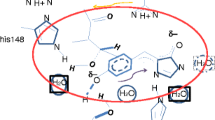Abstract
The excited singlet states of 9-aminophenanthrene and its N-aminoalkyl derivatives are strongly fluorescent in cyclohexane. Addition of low concentrations of Et3N, Pr2NH, or PrNH2 results in a red shift of the emission maximum and moderately decreased fluorescence intensity. Analysis of the fluorescence behavior using a combination of singular value decomposition with self-modeling and kinetic analysis provides evidence for the sequential formation of 1: 1 (exciplex) and 1: 2 (triplex) complexes between the excited 9-aminophenanthrene and ground-state alkylamine, both of which are strongly fluorescent. Both the formation and decay of the exciplex and triplex are dependent upon the extent of amine N-alkylation. Rate constants and equilibrium constants for complex formation follow the order 1° ~ 2° > 3°, analogous to that for the formation of ground-state complexes between amines and the soft Lewis base HgBr2. Similarly, N-aminoalkyl derivatives of 9-aminophenanthrene form intramolecular exciplexes. Excited-state complex formation is attributed to a Lewis acid–base interaction between the excited aminophenanthrene (lone-pair acceptor) and ground-state amine (lone-pair donor). The factors which determine the stability of excited-state Lewis acid–base complexes are characteristic of the specific excited-state acceptor. No universal scale of lone-pair donor strength can be expected to describe the formation of such complexes.
Similar content being viewed by others
References and notes
G. J. Kavarnos, Fundamentals of Photoinduced Electron Transfer, VCH Publishers, New York, 1993
R. Foster, Organic Charge-Transfer Complexes, VCH Publishers, New York, 1969
The Exciplex, ed. M. Gordon and W. R. Ware, Academic Press, New York, 1975
C. Reichardt, Solvents and Solvent Effects in Organic Chemistry, VCH Publishers, Weinheim, 1988
V. Gutmann, The Donor-Acceptor Approach to Molecular Interactions, Plenum Press, New York, 1978
Y. Wang Quenching of singlet and triplet states of p-N,N-dimethylaminobenzonitrile by tertiary amines: intramolecular charge-transfer state and excited-state three-electron bond J. Chem. Soc., Faraday Trans. 2 1988 84 1809
Y. Wang Interaction between intramolecular charge transfer state of p-N,N-dimethylaminobenzonitrile and amines. Stereo-controlled fluorescence quenching Chem. Phys. Lett. 1985 116 286
F. D. Lewis, L.-S. Li, T. L. Kurth, R. S. Kalgutkar The formation and behavior of fluorescent Lewis acid-base exciplexes and triplexes J. Am. Chem. Soc. 2000 122 8573
F. D. Lewis, T. L. Kurth The formation and behavior of fluorescent Lewis acid-base exciplexes and triplexes between 3-aminostilbenes and aliphatic amines J. Phys. Chem. 2004 108 in press
E. A. Chandross, H. T. Thomas Intramolecular exciplex formation in naphthylalkylamines Chem. Phys. Lett. 1971 9 393
L. Zimanyi, A. Kulcsar, J. K. Lanyi, D. F. Sears Jr., J. Saltiel Singular value decomposition with self-modeling applied to determine bacteriorhodopsin intermediate spectra: analysis of simulated data Proc. Natl. Acad. Sci. U. S. A. 1999 96 4408
L. Zimanyi, A. Kulcsar, J. K. Lanyi, D. F. Sears Jr., J. Saltiel Intermediate spectra and photocycle kinetics of the Asp96 → asn mutant bacteriorhodopsin determined by singular value decomposition with self-modeling Proc. Natl. Acad. Sci. U. S. A. 1999 96 4414
V. V. Volkov Separation of additive mixture spectra by a self-modeling method Appl. Spectrosc. 1996 50 320
M. Swaminathan, S. K. Dogra Solvent and pH dependence of fluorescence spectra of 9-phenanthrylamine Can. J. Chem. 1983 61 1064
P. J. Wagner, Steady-state kinetics, in CRC Handbook of Organic Photochemistry, ed. J. C. Scaiano, CRC Press, Boca Raton, 1989
Reversible exciplex and triplex formation was necessary to obtain the best fits
H. Knibbe, D. Rehm, A. Weller Thermodynamics of the formation of excited EDA (electron donor-acceptor) complexes Ber. Bunsen-Ges. Phys. Chem. 1969 73 839
F. D. Lewis Formation and reactions of stilbene exciplexes Acc. Chem. Res. 1979 12 152
P. Jacques, E. Haselbach, A. Henseler, D. Pilloud, P. Suppan Multiple ‘Rehm-Weller plots’ in the electron-transfer quenching of singlet excited 9,10-dicyanoanthracene J. Chem. Soc., Faraday Trans. 1991 87 3811
H. C. Brown, M. D. Taylor Dissociation of the addition compounds of trimethylboron with the ethylamines; configuration of the ethylamines J. Am. Chem. Soc. 1947 69 1332
I. Persson, M. Sandstroem, P. L. Goggin On the coordinating properties of some solvents. A vibrational spectroscopic study of mercury(II) halides and antimony(V) chloride in solution; new concepts for Lewis basicity scales of solvents Inorg. Chim. Acta 1987 129 183
D. Goswami, R. S. Sarpal, S. K. Dogra Fluorescence quenching of few aromatic amines by chlorinated methanes Bull. Chem. Soc. Jpn. 1991 64 3137
N. S. Isaacs, Physical Organic Chemistry, Longman Scientific & Technical and Wiley & Sons, Harlow, 1995
E. A. Chandross, Complexes of dipolar excited states and small polar molecules, in The Exciplex, ed. M. Gordon and W. R. Ware, Academic Press, 1975, pp. 187–207
I. B. Berlman, Handbook of Fluorescence Spectra of Aromatic Molecules, Academic Press, New York, 1971
Photon Technologies International, London, Ontario, Canada
D. R. James, A. Siemiarczuk, W. R. Ware Stroboscopic optical boxcar technique for the determination of fluorescence lifetimes Rev. Sci. Instrum. 1992 63 1710
Mathematica 4.1, Wolfram Research, Inc., Champaign, IL, USA, 2001
Matlab 5.3, release 11, The MathWorks, Inc., Cambridge, MA, USA, 2001
I. P. Beletskaya, A. G. Bessmertnykh, R. Guilard Palladium-catalyzed synthesis of aryl-substituted polyamine compounds from aryl halides Tetrahedron Lett. 1997 38 2287
M. S. Driver, J. F. Hartwig A second-generation catalyst for aryl halide amination: mixed secondary amines from aryl halides and primary amines catalyzed by (DPPF)PdCl2J. Am. Chem. Soc. 1996 118 7217
Author information
Authors and Affiliations
Rights and permissions
About this article
Cite this article
Lewis, F.D., Ahrens, A. & Kurth, T.L. Dynamics and equilibrium for the formation of fluorescent Lewis acid–base exciplexes and triplexes between 9-aminophenanthrene and aliphatic amines. Photochem Photobiol Sci 3, 341–347 (2004). https://doi.org/10.1039/b315162j
Received:
Accepted:
Published:
Issue Date:
DOI: https://doi.org/10.1039/b315162j




